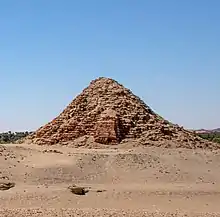| Malewiebamani | |
|---|---|
| Kushite King of Meroe | |
 Pyramid Nuri 11 of Malewiebamani | |
| Predecessor | Nasakhma |
| Successor | Talakhamani |
| Died | ca. 435 BCE |
| Burial | Nuri (Nuri 11) |
| Issue | Talakhamani?, Amanineteyerike and Baskakeren |
| Father | Either Nasakhma or Siaspiqa |
| Mother | Probably Queen Saka'aye |
| Malewiebamani in hieroglyphs | ||||||||||||||
|---|---|---|---|---|---|---|---|---|---|---|---|---|---|---|
| Era: Late Period (664–332 BC) | ||||||||||||||
Malewiebamani was a Kushite King of Meroe.
Prenomen: Kheperkare ("Re is one whose ka is manifest") Nomen: Malewiebamani
Malewiebamani's mother was likely Queen Saka'aye. Malewiebamani was the son of either Nasakhma or Siaspiqa.
Amanineteyerike and Baskakeren are thought to be sons of Malewiebamani.[1]
Malewiebamani succeeded Nasakhma and in turn was succeeded by Talakhamani, who could be either a son or a younger brother of Malewiebamani.[1][2]
A Royal wife named Akhrasan from the time of Malewiebamani was buried at Nuri. Her relation to the king is not known.[1]
Malewiebamani's name is known from a Shawabti and from intrusive items from pyramid Nuri 16 bearing his name. On the dedication stela of Aspelta, a private name occurs which is very similar to Malewiebamani's name. His nomen appears at Kawa.[1]
References
- 1 2 3 4 Dows Dunham and M. F. Laming Macadam, Names and Relationships of the Royal Family of Napata, The Journal of Egyptian Archaeology, Vol. 35 (Dec., 1949), pp. 139-149
- ↑ Samia Dafa'alla, Succession in the Kingdom of Napata, 900-300 B.C., The International Journal of African Historical Studies, Vol. 26, No. 1 (1993), pp. 167-174
